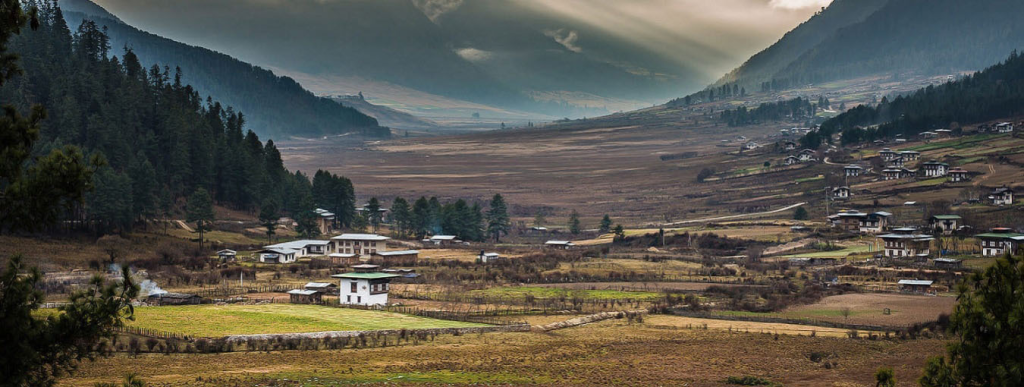Phobjikha Valley and Gangtey Goempa

One of Bhutan’s most stunning locations in Bhutan is inevitably the Gangtey valley. A sensation of great openness is added to the surprise of finding such a large, flat valley devoid of trees after the challenging ascent through dense forests. This is a very rare experience in Bhutan, since the majority of the valleys are densely confined. Phobjikha village is located down the valley, a few kilometers beyond the Gangtey Monastery. Black-necked cranes migrate to this area from the parched plains of the north to spend the winter in a milder environment.
At 2900 meters above sea level, Phobjikha is part of the Wangduephodrang district and is situated outside of the Black Mountain National Park. The Nakay Chhu (Chhu Naap-black water) and Gay Chhu rivers, two lovely flowing rivers, are located in the valley (Chhu Karp-white water).
A local myth holds that the two rivers actually stand for a snake and a boar. The snake (Nakay Chhu) and the boar formerly competed in a race with the understanding that if the snake won, rice could be grown in the Phobjikha valley; however, if the boar won, rice could never be grown in the region. The snake lost since its journey required it to meander constantly. Even now, rice cannot be grown in the valley.
PLACES TO VISIT IN PHOBJIKHA
THE PLACE OF GANGTEY TRUELKU

Perched on a small hill that rises from the valley floor, the Gangtey Monastery is the only Nyingmapa monastery on the western side of Bhutan and also the biggest Nyingmapa monastery in Bhutan. The Monastery is surrounded by a small clustered village inhabited mainly by the families of the 140 Gomchens who take care of the Monastery.
Gangtey was founded by Pema Trinley, the grandson of Pema Lingpa, the famous Nyingmapa saint of Bhutan. In 1613, Pema Trinley establish the monastery and became the first Gangtey Truelku. The religious tradition of Pema Lingpa is still being taught in Gangtey. The second Tulku, Tenzin Legpa Dondrup , enhanced the size of Gangtey while keeping up good relations with Drukpas, and later on rebuilt the monastery in the form of a Dzong.
BLACK NECKED CRANE

It is extremely rare to find black necked crane in Bhutan, and only few places give the opportunity to spot this bird. Phobjikha valley is one among many. This experience is made worth with the presence of Black-necked Crane Information Center which features an observation room with a high-power telescope and spotting scopes for getting the greatest view of the cranes. It is located on the border of the forest and marsh along the main road of Phobjikha Valley. The center also gives information outlining the region’s natural and cultural history. Additionally, there is a tiny gift shop where you may buy locally made crafts, which tourist can probably take as souvenir.
OPEN VAST LAND

Phobjikha valley in itself is a wide open field, every part filled with greenery and enclosed with dense forest, while the open sky always gives a view of azure sky. The place is equally commendable for its location for photo shoot. The view is stunningly beautiful and makes it an attractive place not only for tourist but even for the locals and regional tourist.